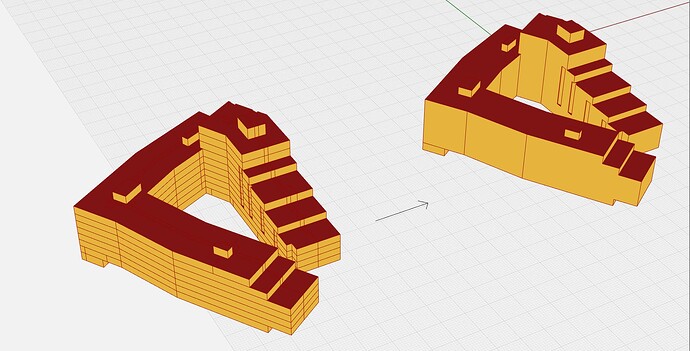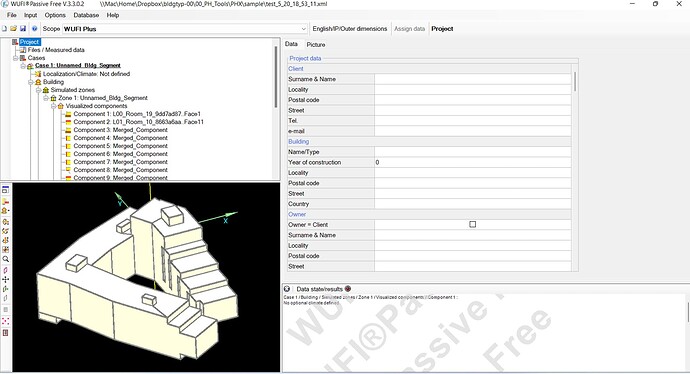FWIW, in case anyone finds this thread in the future, I was able to make this work reasonably well (it’s not fast… but fairly consistent at least) using the implementation shown below (GH file attached for reference).
import scriptcontext as sc
from copy import copy
import math
from ladybug_geometry.geometry3d.plane import Plane
from ladybug_geometry.geometry2d.pointvector import Vector2D
from ladybug_geometry.geometry3d.pointvector import Vector3D
from ladybug_geometry.geometry2d.polygon import Polygon2D
from ladybug_geometry.geometry3d.face import Face3D
from ladybug_rhino.fromgeometry import from_point3d
from honeybee import room, face
from honeybee.aperture import Aperture
def cross_product(a, b):
# type: (List[float], List[float]) -> List[float]
return [
a[1]*b[2] - a[2]*b[1],
a[2]*b[0] - a[0]*b[2],
a[0]*b[1] - a[1]*b[0]
]
def dot_product(a, b):
# type: (List[float], List[float]) -> float
return sum([a[i]*b[i] for i in range(len(a))])
def magnitude(a):
# type: (List[float]) -> float
return sum([a[i]**2 for i in range(len(a))])**0.5
def normalize(a):
# type: (List[float) -> List[float]
mag = magnitude(a)
return [a[i]/mag for i in range(len(a))]
def angle_between_planes(plane1, plane2, _tolerance):
# type: (Plane, Plane, float) -> float
# Calculate the x-axes of the planes
plane1_xaxis = cross_product(plane1.n, plane1.x)
plane2_xaxis = cross_product(plane2.n, plane2.x)
# Normalize the x-axes
plane1_xaxis = normalize(plane1_xaxis)
plane2_xaxis = normalize(plane2_xaxis)
# Calculate the dot product between the x-axes
dot_product_value = dot_product(plane1_xaxis, plane2_xaxis)
# Calculate the angle between the x-axes
# Handle parallel or coincident planes
if (1.0 - dot_product_value) < _tolerance:
return 0.0
angle_rad = math.acos(dot_product_value)
# Determine the counterclockwise angle
orientation = cross_product(plane1_xaxis, plane2_xaxis)
if dot_product(plane1.n, orientation) < 0:
angle_rad = 2 * math.pi - angle_rad
return angle_rad
def _get_polygon2d_in_reference_space(_polygon2d, _poly2d_plane, _base_plane, _tolerance):
# type: (Polygon2D, Plane, Plane, float) -> Polygon2D
"""Return a Polygon2D in the reference space of the base polygon."""
# -- Create a Vector2D from each face's origin to the base-geom's origin
base_plane_x_vec = _base_plane.x
face_origin_in_base_plane_space = _base_plane.xyz_to_xy(_poly2d_plane.o)
base_plane_origin = copy(_base_plane.xyz_to_xy(_base_plane.o))
# -- Construct a Move vector from the face's origin to the base-plane's origin
mv_x = face_origin_in_base_plane_space.x - base_plane_origin.x
mv_y = face_origin_in_base_plane_space.y - base_plane_origin.y
move_vec = Vector2D(mv_x, mv_y) # type: ignore
# ------------------------------------------------------------------------
# -- Move the face's Polygon2D into the base polygon's space
moved_polygon = _polygon2d.move(move_vec)
# ------------------------------------------------------------------------
# -- Rotate the Polygon to align with the base-plane
angle = angle_between_planes(_base_plane, _poly2d_plane, _tolerance)
rotated_polygon = moved_polygon.rotate(angle=angle, origin=face_origin_in_base_plane_space)
return rotated_polygon
def _create_new_HB_Face(_face3D, _ref_face):
# type: (Face3D, Face) -> Face
"""Create a new HB-Face using a Face3D and a reference HB-Face."""
new_face = face.Face(
identifier=_ref_face.identifier,
geometry=_face3D,
type=_ref_face.type,
boundary_condition=_ref_face.boundary_condition,
)
new_face.display_name = _ref_face.display_name
new_face._user_data = (
None if _ref_face.user_data is None else _ref_face.user_data.copy()
)
new_face._properties._duplicate_extension_attr(_ref_face._properties)
return new_face
def _create_new_Face3D(_poly2D, _base_plane, _ref_face):
# type: (Polygon2D, Plane, Face) -> Face3D
return Face3D(
boundary=tuple(_base_plane.xy_to_xyz(v) for v in _poly2D.vertices),
plane=_ref_face.geometry.plane,
)
def _add_sub_face(_face, _aperture):
# type: (Face, Aperture) -> Face
"""Add an HB-sub-face (either HB-Aperture or HB-Door) to a parent Face.
NOTE: this method is copied from honeybee's Grasshopper component "HB Add Subface"
"""
if isinstance(_aperture, Aperture): # the sub-face is an Aperture
_face.add_aperture(_aperture)
else: # the sub-face is a Door
_face.add_door(_aperture)
return _face
def _check_and_add_sub_face(_face, _apertures, _tolerance, _angle_tolerance,):
# type: (Face, List[Aperture], float, float) -> None
"""Check whether a HB-sub-face is valid for an HB-face and, if so, add it.
NOTE: this method is copied from honeybee's Grasshopper component "HB Add Subface"
"""
for aperture in _apertures:
if _face.geometry.is_sub_face(aperture.geometry, _tolerance, _angle_tolerance):
_add_sub_face(_face, aperture)
def find_parent_and_child_polygons(_polygons):
# type: (List[Polygon2D]): -> Tuple[List[Polygon2D], List[Polyon2D]]
# Initialize empty lists for parent and child surfaces
parent_polygon = []
child_polygons = []
# Compare each surface with all other surfaces
for i, _polygon in enumerate(_polygons):
is_inside_any = False
for j, other_polygon in enumerate(_polygons):
if i == j:
continue
if _polygon.is_polygon_inside(other_polygon):
is_inside_any = True
break
# If the surface is inside any other surface, add it to child_surfaces
# Otherwise, it is a parent surface
if is_inside_any:
parent_polygon.append(_polygon)
else:
child_polygons.append(_polygon)
return parent_polygon, child_polygons
def _merge_hb_face_group(_faces, _tolerance, _angle_tolerance):
# type: (List[Face], float, float) -> List[Face]
"""Merge a group of HB-Faces into the fewest number of faces possible."""
if not _faces:
return []
if len(_faces) == 1:
return _faces
# -------------------------------------------------------------------------
# -- Before anything else, preserve all the Apertures for adding back in later
apertures = []
for f in _faces:
apertures.extend([ap.duplicate() for ap in f.apertures])
# -------------------------------------------------------------------------
# -- This will be the reference face for everything else to match
reference_face = _faces.pop(0).duplicate() # type: face.Face
reference_plane = copy(reference_face.geometry.plane)
polygons_in_ref_space = [
reference_face.geometry.polygon2d,
]
# -------------------------------------------------------------------------
# -- Get all the Polygon2Ds in the same reference space
poly2ds = (f.geometry.polygon2d for f in _faces)
planes = (f.geometry.plane for f in _faces)
for poly2d_plane, poly2d in zip(planes, poly2ds):
polygons_in_ref_space.append(
_get_polygon2d_in_reference_space(poly2d, poly2d_plane, reference_plane, _tolerance)
)
# -------------------------------------------------------------------------
# -- Merge all the new Polygon2Ds together.
merged_polygons = Polygon2D.boolean_union_all(polygons_in_ref_space, _tolerance)
# -------------------------------------------------------------------------
# -- Create new Face3D and HB-Faces from the Polygon2Ds
faces = []
if len(merged_polygons) == 1:
# -- Create new faces for the merged Polygon2Ds
face3ds = [_create_new_Face3D(p, reference_plane, reference_face) for p in merged_polygons]
faces = [_create_new_HB_Face(f3d, reference_face) for f3d in face3ds]
elif len(merged_polygons) > 1:
# -- It may mean that there are 'holes' in a surface? So try and find
# -- the parent and any child surfaces.
parent_polygon, child_polygons = find_parent_and_child_polygons(merged_polygons)
# -- Check the results
if len(parent_polygon) != 1:
# -- Something went wrong, give up.
_faces.append(reference_face)
return _faces
# -- If only 1 parent, lets make some Face3Ds and Faces
parent_face_3d = [_create_new_Face3D(p, reference_plane, reference_face) for p in parent_polygon]
child_face_3ds = [_create_new_Face3D(p, reference_plane, reference_face) for p in child_polygons]
face_3ds = [Face3D.from_punched_geometry(parent_face_3d[0], child_face_3ds)]
faces = [_create_new_HB_Face(f3d, reference_face) for f3d in face_3ds]
# -------------------------------------------------------------------------
# -- Add the apertures back in
faces_with_apertures_ = []
for _face in faces:
_check_and_add_sub_face(_face, apertures, _tolerance, _angle_tolerance)
faces_with_apertures_.append(_face)
return faces_with_apertures_
# -- Create new merged faces
new_faces_ = []
for face_group in _face_groups.Branches:
new_faces_.extend(
_merge_hb_face_group(
list(face_group),
sc.doc.ModelAbsoluteTolerance,
sc.doc.ModelAngleToleranceDegrees
)
)
I’m sure it could use a lot of cleaning up, but seems good enough for now.
best
@edpmay
merge_example.gh (421.2 KB)


